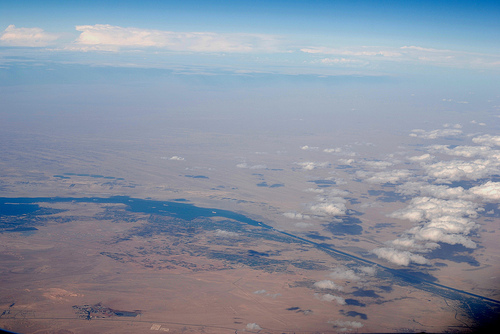Suez Canal has become a worldwide benefit.
- The man-made Suez Canal is the lengthiest canal without locks in the world, and it is located in Africa’s Egypt, and links the Red and Mediterranean Seas together.
- As of 2010, Suez Canal had a length of 193.3 kilometres (120 miles), a maximum width of 345 metres (377 yards) at the water level, and reached 24 metres (78.7 feet) in depth, and the canal crossings included two bridges and one tunnel.
- The Suez Canal Authority owns the canal, and any ship is legally allowed to travel the canal for any purpose as long as they abide by the stated rules; and the number of ships that used the canal in 2008 numbered 21,415, equaling approximately eight percent of the world shipping trade.
- A canal that connected the Mediterranean and Red Seas via the Nile River, is said to have been first built in 1874 BC by Senausert III, an Egyptian pharaoh, while other pharaohs reopened the waterway throughout history, until the Suez Canal was constructed in the 19th century.
- The legal authorisation for the construction of Suez Canal was granted to Frenchmen Ferdinand de Lesseps, a diplomat, in 1854 although it wasn’t until 1859 that construction began.
Suez Canal
Image courtesy of Wilhelm Joys Andersen/Flickr
- The Suez Canal was opened on 17 November 1869 by the French, while the original estimated cost of the canal was less than half of the actual cost.
- Although under-used in the first couple of years, the Suez Canal quickly became a staple part of world trade and movement, allowing for much shorter trips around the Earth, and a time saving of as much as 88% on some routes.
- Suez Canal cannot support two watercraft abreast, and therefore the ships move in a scheduled convoy that takes 12 to 16 hours to travel the length of the canal, while a bypass area is used to pass oncoming boats.
- Due to the Red Sea’s unique environment, the connection of the seas by the Suez Canal has caused much environmental damage to the Mediterranean Sea.
- In 2014, at an estimated cost of $8.4 billion, construction began on a second canal of 72 km (44.7 miles) in length, to be connected and run parallel to the Suez Canal, to expand its capacity, and to be completed by the end of 2015.
Bibliography:
Canal History, 2008, Suez Canal Authority, http://www.suezcanal.gov.eg/sc.aspx?show=8
Canal Characteristics, 2008, Suez Canal Authority, http://www.suezcanal.gov.eg/sc.aspx?show=12
Suez Canal, 2015, Wikipedia, http://en.wikipedia.org/wiki/Suez_Canal








